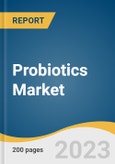The global probiotics market size is expected to reach USD 220.14 billion by 2030, growing at a CAGR of 14.0% from 2023 to 2030. The market is experiencing steady growth driven by several factors including shifting dietary preferences toward healthier foods coupled with the rising consumer awareness about digestive health products. Manufacturers in the industry are increasingly focused on distribution agreements and partnerships for probiotic sales. For instance, in September 2020, OptiBiotix Health Plc., a UK-based probiotic nutritional supplement manufacturer, announced an exclusive distribution agreement with Ayalla Marketing for the former’s product distribution in Brazil. In such an agreement, manufacturers often decide the minimum order quantity to facilitate cost-effective shipments.
In addition, Meluka Australia, a company that expanded its probiotic range in collaboration with Probiotics Australia in 2021, also expanded its retail channels through other strategic alliances. The company launched an e-commerce channel via WhatsApp in March 2022. It implemented a conversational messaging technology offered by Gupshup for customer engagement. Its e-commerce store is accessible to Australian customers via the WhatsApp platform. Moreover, e-commerce is increasingly becoming popular owing to the availability of a wide range of supplements and probiotic food products. Various companies, especially new entrants, in the global market are collaborating with e-commerce companies to promote their products as well as achieve maximum market penetration.
In addition, supplement manufacturers are increasingly incorporating functional ingredients into products to increase their nutritional value. Ingredient suppliers and supplement manufacturers are focusing on product innovation to expand their portfolio of probiotics and probiotic-based foods and better cater to the specific nutrition conditions of consumers with digestive health problems. For example, in August 2021, SkinBio Therapeutics launched new probiotic supplements targeted at the skin condition psoriasis. This product launch was aimed at expanding the use of probiotics in different application areas.
This product will be delivered within 1-3 business days.
In addition, Meluka Australia, a company that expanded its probiotic range in collaboration with Probiotics Australia in 2021, also expanded its retail channels through other strategic alliances. The company launched an e-commerce channel via WhatsApp in March 2022. It implemented a conversational messaging technology offered by Gupshup for customer engagement. Its e-commerce store is accessible to Australian customers via the WhatsApp platform. Moreover, e-commerce is increasingly becoming popular owing to the availability of a wide range of supplements and probiotic food products. Various companies, especially new entrants, in the global market are collaborating with e-commerce companies to promote their products as well as achieve maximum market penetration.
In addition, supplement manufacturers are increasingly incorporating functional ingredients into products to increase their nutritional value. Ingredient suppliers and supplement manufacturers are focusing on product innovation to expand their portfolio of probiotics and probiotic-based foods and better cater to the specific nutrition conditions of consumers with digestive health problems. For example, in August 2021, SkinBio Therapeutics launched new probiotic supplements targeted at the skin condition psoriasis. This product launch was aimed at expanding the use of probiotics in different application areas.
Probiotics Market Report Highlights
- The demand for probiotic dietary supplements is expected to grow at a CAGR of 14.1% from 2023 to 2030, driven by the growing consumer awareness of the health benefits offered by probiotic supplements
- The demand for yeast-based probiotics is projected to grow at a CAGR of 13.4% during the forecast period. Dietary supplements are made using yeast as it has proteins, amino acids, vitamin B, and peptides, and is safe for all age groups
- The sales of probiotics through supermarkets/hypermarkets dominated the market in 2022 with a revenue share of over 30% and are expected to continue dominance throughout the forecast period. The availability of a wide range of product offerings, also enabling easy comparisons for customers, is expected to drive this dominance
- The demand for probiotics in the Middle East & Africa region is expected to grow at a CAGR of nearly 15% during the forecast period. It is mainly driven by the increasing demand in countries, such as Saudi Arabia, South Africa, and UAE
This product will be delivered within 1-3 business days.
Table of Contents
Chapter 1. Methodology and Scope
Chapter 3. Probiotics Market Industry Outlook
Chapter 4. Global Probiotics Market: Product Estimates & Trend Analysis
Chapter 5. Global Probiotics Market: Ingredient Estimates & Trend Analysis
Chapter 6. Global Probiotics Market: End - Use Estimates & Trend Analysis
Chapter 7. Global Probiotics Market: Distribution Channel Estimates & Trend Analysis
Chapter 8. Probiotics Market: Regional Estimates & Trend Analysis
Chapter 9. Competitive Landscape
List of Tables
List of Figures
Companies Mentioned
- Arla Foods Group
- BioGaia AB
- Chr. Hansen Holding A/S
- Danone
- DuPont De Nemours, Inc.
- General Mills, Inc.
- i - Health, Inc.
- Lallemand Inc.
- Lifeway Foods Inc
- Mother Dairy Fruit & Vegetable Pvt. Ltd
- Kerry
- Nestle S.A.
- Probi AB
- Yakult Honsha Co., Ltd.
Methodology

LOADING...
Table Information
| Report Attribute | Details |
|---|---|
| No. of Pages | 200 |
| Published | August 2023 |
| Forecast Period | 2022 - 2030 |
| Estimated Market Value ( USD | $ 77.12 Billion |
| Forecasted Market Value ( USD | $ 220.14 Billion |
| Compound Annual Growth Rate | 14.0% |
| Regions Covered | Global |
| No. of Companies Mentioned | 14 |









